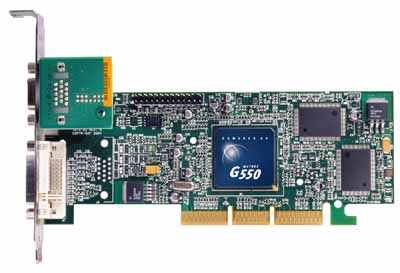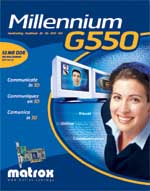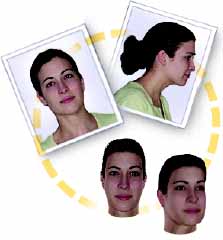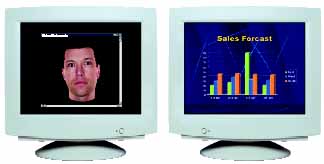
Original Link: https://www.anandtech.com/show/789
Matrox Millennium G550: Matrox's Next-Generation chip arrives
by Anand Lal Shimpi on June 19, 2001 12:39 AM EST- Posted in
- GPUs
It’s always interesting to see how rumors get started and spread like wildfire; it’s even more interesting to see it happen when you know for certain what’s being spread isn’t true. Such was the case with the rumors that surrounded Matrox’s “next-generation” graphics part. It wasn’t long after the release of the Matrox G400 that rumors of a G600 and a G800 began surfacing; although most had no factual basis at all. As the story goes with most rumors, the misinformation compounded until even Matrox was worried that when the truth was revealed there would be a backlash from the community for not producing a product that never made it to production.
It isn’t entirely unusual for a manufacturer to produce a product that doesn’t make it to mass production, so there’s no doubt in our minds that there ever was a basis for a G800 just like there once was a socketed Pentium II processor floating around Intel (and a very big one at that) and ATI’s labs have definitely housed some unique creations.
During Comdex of last year we learned of the slight possibility that Matrox would be producing a mid-range gaming card. Plans for that were eventually scrapped and instead what Matrox focused their attentions on was an updated version of the G450. Considering that the G450 was an updated version of the G400, we feared that Matrox’s backlash would come not because they couldn’t deliver on a rumor but because their “next-generation” part was based on the two-year-old G400.
Matrox’s G550
Matrox has had a way of creating markets for their products that didn’t exist before. They were the first to truly promote and show the world what Environment Mapped Bump Mapping (EMBM) could offer. How could we ever forget that one Expendable screen shot that made almost everyone want a G400 for the sole purpose of having bumpy water? Then they convinced the world that dual monitors wasn’t just for the high-end anymore, it could be used in games, internet browsing and document editing among the usual array of applications.
Both EMBM and DualHead have managed to become check-box features that competing vendors have also implemented because of user demand. It would seem as if Matrox has had a handful of relative successes in creating markets for their features.
Matrox’s latest foray into the graphics market attempts to build on their successes of the past and create yet another market with the G550. Although they’ve always said that the third time is a charm, it looks like that may not be the case for Matrox.
The Chip
The G550 is much like the G450; we’ve described the few differences that exist in the chip itself here. For more information about the G550’s feature set you can consult our original G450 review.

The G550 is built on a 0.18-micron process and the chip itself is pin compatible with the older G450. This immediately tells us that there are no additional memory interface pins meaning that the G550 still has the same 64-bit DDR memory interface borrowed from the G450. The fact that it is pin compatible makes board layout and implementation very easy, but it also means that the chip is still very memory bandwidth bottlenecked as the older G450 couldn’t even offer greater 3D performance than the original G400. The chip supports memory configurations up to 32MB in size.
The rendering pipeline of the G550 has changed somewhat from the G450; the chip still has two rendering pipelines but now is capable of applying two textures to every pixel rendered in one clock. For a reference point, NVIDIA introduced this feature with their GeForce2 GTS about a year ago.
The G550 is not a DX8 part although it does have some DX8 functions. The only reason it could be somewhat considered to be one is that it has a Vertex Shader unit but no pixel shader unit. The G550 does have a custom made T&L engine; it is a programmable RISC engine that is really only useful for one T&L function which is Matrix Pallette Skinning.
 As
you will remember from our ATI Radeon and NVIDIA GeForce3 reviews, Matrix Pallette
Skinning allows for smooth vertices such as those that would be present in the
joints of a human face or body. Properly implemented Matrix Pallette Skinning
can make a character look noticeably better than what you may be used to seeing,
but it is still a relatively infrequently used function in games today.
As
you will remember from our ATI Radeon and NVIDIA GeForce3 reviews, Matrix Pallette
Skinning allows for smooth vertices such as those that would be present in the
joints of a human face or body. Properly implemented Matrix Pallette Skinning
can make a character look noticeably better than what you may be used to seeing,
but it is still a relatively infrequently used function in games today.
The DualHead functionality of the G550 is virtually identical to that of the G450. The outputs on the first G550 cards will be in the form of one 15-pin VGA connector and one DVI-I connector. The DVI-I connector can be used as a second VGA output using a supplied converter connector.
According to Matrox, the die size of the G550 is apparently not much larger than the G450, leading us to believe that implementation of the T&L engine on the chip is not that complex.
The first cards using the G550 will be called the Millennium G550 and are going to be priced at $125.
Targeting and Performance
Just like the G450, the G550 is targeted as far away from the gamer as possible. The 3D performance of the card is in the same category as the Radeon VE or the GeForce2 MX200 although even those two should be able to offer greater performance than the G550.
For the expected performance levels of the card, if you are interested, check out our original G450 review.
Matrox’s HeadCasting Technology
At this point the G550 looks like nothing more than a G450 with an odd T&L engine but it’s this “odd” T&L engine that Matrox is centering the main feature of the G550 on; that feature is HeadCasting.
Matrox is positioning the G550 as the centerpiece to being able to do Graphics over IP, essentially low bandwidth video conferencing. The problem with video conferencing over the net right now is the lack of bandwidth between the users engaging in the video conference. This results in poor quality video, stuttering and a general loss of the original intent of being able to see the person you are talking to. HeadCasting works in very low bandwidth situations, such as over a 56K modem connection, by only sending vertex data and relying on the G550 to manipulate a 3D model of the head of the person you are conferencing with.
The process works like this:
1) Both users that want to use HeadCasting must have a Matrox G550 card (if one user doesn't have a G550 the process is possible but there is a degradation in quality). They take two pictures of their faces, one of the front of their face and one of the side (a profile).
2) These images are sent to a company called Digimask. Digimask has partnered with Matrox and will send you a 3D model of your head interpolated from the two pictures you emailed them.
3) The two users will exchange 3D head models via email (or any file transfer protocol).

At this point you have a 3D model of your head but you haven’t done anything that requires the G550 yet. This is where a piece of software bundled with the Millennium G550 comes into play: HeadFone. Developed by LIPSinc, HeadFone is provided with the Millennium G550 in a version that supports Matrox’s HeadCasting (essentially their Matrix Pallette Skinning T&L engine). This software uses voice patterns to instruct the G550’s T&L engine to move the lips on the 3D model of your head while you are speaking into a microphone.
Since your counterpart will already have a copy of your 3D head on his/her machine locally, the only data that must be sent over the net is the vertex data for the movement of your lips and the voice data of course. This will allow for relatively lifelike movements of your 3D head’s lips over a very low bandwidth connection, such as a 56K modem.

The 3D head and its animation is better than what you’d see in most 3D games, but is still far away from being realistic enough to replace video conferencing. Although nothing is stopping from other manufacturers from offering their own HeadCasting engines, Matrox does have a bit of a leg up on the competition since their T&L core has 256 constant registers to store the appropriate animation matrices. The GeForce3 has approximately half of that number of registers but can obviously do much more than just Matrix Pallette Skinning. Future ATI and NVIDIA cards will be able to offer equivalent animation horsepower but for now Matrox does have an advantage in that respect. ATI and NVIDIA could implement a feature similar to Matrox’s HeadCasting technology but with using a slightly less detailed animation process if they really wanted to become competitive in this area.
Remember that the G550’s T&L unit is only really useful for Matrix Pallette Skinning and vertex shading, which come in very handy with HeadCasting. However since their T&L unit is so tailored to just these features Matrox has made the drivers disable the T&L unit in all applications/games other than those that are HeadCasting specific. You’re not losing out on much since very few applications/games made use of this level of facial animation/shading.
If only one user has a G550 and they want to communicate using this technology, the user without the G550 will receive a "low definition 3D head" while the G550 user will have a higher quality version.

Matrox also bundles their Visual Presenter for PowerPoint with the Millennium G550; this plug-in for PowerPoint 2000 and XP allows you to record your 3D head and your voice alongside your PowerPoint presentation so that when it is viewed your 3D head appears and talks while the slideshow is running. Since the 3D head is pre-rendered, this will play fine on all machines. On systems with DualHead, the 3D head will have the option of being displayed on one screen while the slide show runs on another.
Final Words
Matrox is looking to send us a G550 evaluation card in the coming weeks, however as you can probably tell we have not been overly impressed with the technology. The redeeming qualities of the G550 are its excellent 2D (supposedly improved slightly over the G450) and its DualHead multi-monitor display both of which were provided with the G450.
Matrox’s HeadCasting technology is interesting for low-bandwidth users however it is entirely too artificial for conducting real business over the net. Matrox states that the G550’s HeadCasting technology enables “professionals to establish stronger relationships with partners, contacts and clients…” but we believe that a 3D model of your talking head isn’t going to help close many deals in the business world. Plus, how many businesses that need this sort of communication don’t have relatively high bandwidth connections to the internet thus allowing conventional video conferencing to work just fine?
The biggest shortcoming of Matrox’s HeadCasting technology is that it requires that both ends of the communication line have a G550 card. At this point it’s assuming a little too much from the market to be that accepting of the G550. Update: Matrox has informed us that both users don't need a G550; if a user doesn't have a G550 then they will receive a "low definition 3D head model."
The G550 can be sold based on the solid 2D and DualHead that were introduced with the G450, but convincing corporations or even just home users that HeadCasting technology is a feature they need to have is going to be a tough task for Matrox’s marketing department. With DualHead you could offer increased productivity, and EMBM was captivating to the gaming audience but HeadCasting is going to be a very tough sell for Matrox.
If it weren’t for the $125 price tag of the card there would be no reason to consider it, but at that price point it is reasonable if all you’re concerned about is good 2D and multi-monitor support. Assuming history repeats itself Linux support could be another reason to consider the G550 as the G450 was a success under Linux. The G550 shouldn’t cost much more than a G450 to manufacture if the die sizes are relatively similar, making it unlikely that the G450 will drop too far in price because of the G550’s release.
It’s interesting how the graphics market has changed since Matrox released the G400, but the one thing that is important to note is that all of the surviving companies in the graphics market are using new chip designs other than what they had two years ago. It’s time for Matrox to do the same; hopefully for Matrox’s sake, their elusive DX8 part will eventually surface.







